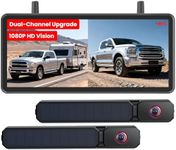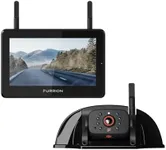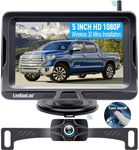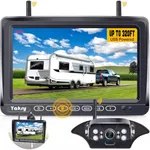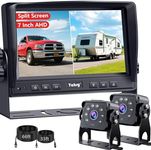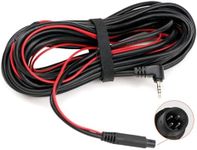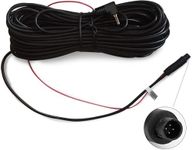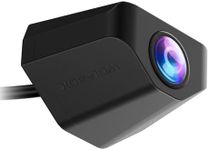Buying Guide for the Best Wireless Backup Cameras
Choosing a wireless backup camera can make parking and reversing much safer and easier, especially for larger vehicles or those with limited rear visibility. The right camera for you will depend on your vehicle type, how you plan to use it, and your preferences for installation and features. Understanding the key specifications will help you find a camera that fits your needs and gives you peace of mind when driving.Image ResolutionImage resolution refers to how clear and detailed the camera's video feed will be. Higher resolution means a sharper image, making it easier to spot obstacles or small objects behind your vehicle. Most wireless backup cameras offer resolutions ranging from standard definition (SD) to high definition (HD). SD cameras are usually enough for basic reversing, but if you want a clearer view, especially in larger vehicles or for frequent use, an HD camera is a better choice. Consider how much detail you need to see and how often you'll rely on the camera when deciding on resolution.
Field of ViewThe field of view is the width of the area the camera can capture behind your vehicle. A wider field of view lets you see more of what's behind and to the sides, which is helpful for spotting approaching cars or pedestrians. Cameras typically range from about 90 degrees (narrow) to 170 degrees (very wide). A narrow view might be enough for small cars or simple parking, while a wider view is better for larger vehicles or if you want maximum coverage. Think about your parking situations and how much of the area behind your car you want to see.
Night VisionNight vision allows the camera to provide a usable image in low light or darkness, usually with the help of infrared LEDs. This is important if you often park or reverse at night or in dimly lit areas. Some cameras offer basic night vision, which is enough for seeing large objects, while others provide clearer images with more detail. If you expect to use the camera in dark conditions, look for one with strong night vision capabilities.
Wireless RangeWireless range is the maximum distance the camera's signal can travel to reach the display inside your vehicle. This is especially important for longer vehicles like trucks, vans, or RVs. Shorter ranges are fine for small cars, but if you have a larger vehicle or plan to mount the camera far from the display, look for a model with a longer wireless range to ensure a stable connection. Consider the size of your vehicle and where you plan to install the camera and monitor.
Display Type and SizeThe display is the screen where you'll view the camera feed. Some systems come with their own monitor, while others connect to your existing screen or rearview mirror. Display sizes vary, with larger screens making it easier to see details but taking up more space. If you want a simple setup, a camera that uses your current screen might be best. If you prefer a dedicated display, think about where you'll mount it and what size will be comfortable for you to use.
Weather ResistanceWeather resistance means the camera can handle rain, dust, and other outdoor conditions. Look for cameras with a good waterproof or weatherproof rating, especially if you live in an area with harsh weather or plan to use the camera year-round. A camera with strong weather resistance will last longer and perform better in all conditions. Consider your local climate and how exposed the camera will be on your vehicle.
Installation MethodInstallation method refers to how the camera and display are mounted and powered. Some cameras are designed for easy DIY installation, while others may require more work or professional help. Wireless cameras are generally easier to install than wired ones, but you still need to connect them to a power source. Think about your comfort level with installation and whether you want a system that's quick to set up or are willing to spend more time for a more integrated look.



